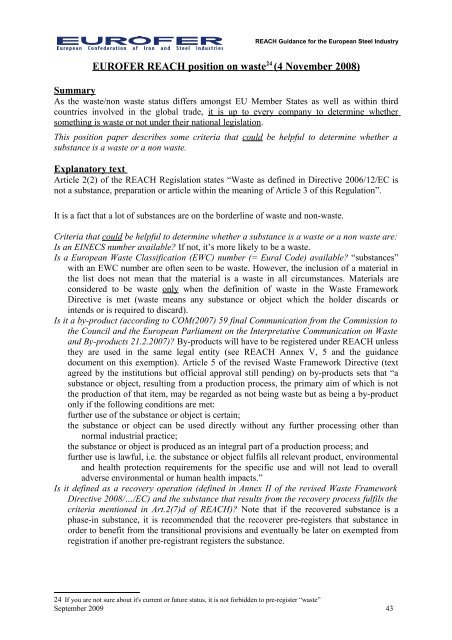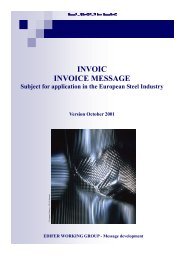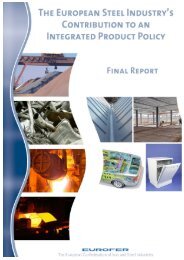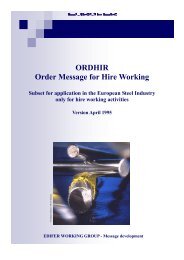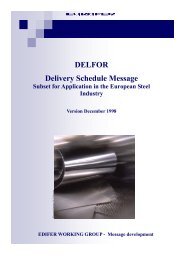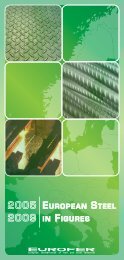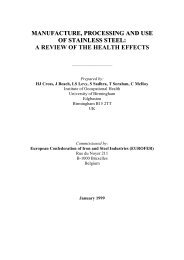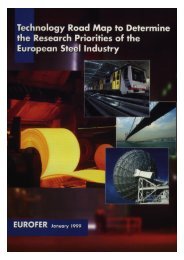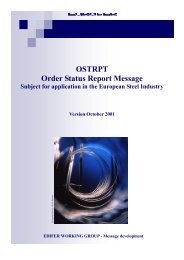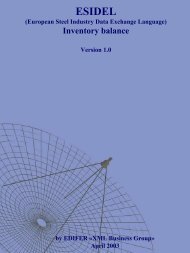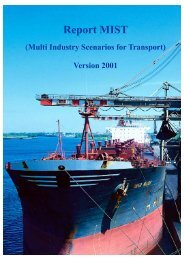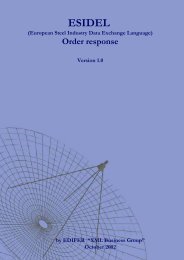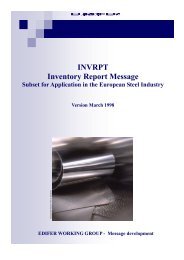EUROFER REACH guidance for the European Steel Industry. 09.09 ...
EUROFER REACH guidance for the European Steel Industry. 09.09 ...
EUROFER REACH guidance for the European Steel Industry. 09.09 ...
Create successful ePaper yourself
Turn your PDF publications into a flip-book with our unique Google optimized e-Paper software.
<strong>REACH</strong> Guidance <strong>for</strong> <strong>the</strong> <strong>European</strong> <strong>Steel</strong> <strong>Industry</strong><br />
<strong>EUROFER</strong> <strong>REACH</strong> position on waste<br />
24<br />
(4 November 2008)<br />
Summary<br />
As <strong>the</strong> waste/non waste status differs amongst EU Member States as well as within third<br />
countries involved in <strong>the</strong> global trade, it is up to every company to determine whe<strong>the</strong>r<br />
something is waste or not under <strong>the</strong>ir national legislation.<br />
This position paper describes some criteria that could be helpful to determine whe<strong>the</strong>r a<br />
substance is a waste or a non waste.<br />
Explanatory text<br />
Article 2(2) of <strong>the</strong> <strong>REACH</strong> Regislation states “Waste as defined in Directive 2006/12/EC is<br />
not a substance, preparation or article within <strong>the</strong> meaning of Article 3 of this Regulation”.<br />
It is a fact that a lot of substances are on <strong>the</strong> borderline of waste and non-waste.<br />
Criteria that could be helpful to determine whe<strong>the</strong>r a substance is a waste or a non waste are:<br />
Is an EINECS number available? If not, it’s more likely to be a waste.<br />
Is a <strong>European</strong> Waste Classification (EWC) number (= Eural Code) available? “substances”<br />
with an EWC number are often seen to be waste. However, <strong>the</strong> inclusion of a material in<br />
<strong>the</strong> list does not mean that <strong>the</strong> material is a waste in all circumstances. Materials are<br />
considered to be waste only when <strong>the</strong> definition of waste in <strong>the</strong> Waste Framework<br />
Directive is met (waste means any substance or object which <strong>the</strong> holder discards or<br />
intends or is required to discard).<br />
Is it a by-product (according to COM(2007) 59 final Communication from <strong>the</strong> Commission to<br />
<strong>the</strong> Council and <strong>the</strong> <strong>European</strong> Parliament on <strong>the</strong> Interpretative Communication on Waste<br />
and By-products 21.2.2007)? By-products will have to be registered under <strong>REACH</strong> unless<br />
<strong>the</strong>y are used in <strong>the</strong> same legal entity (see <strong>REACH</strong> Annex V, 5 and <strong>the</strong> <strong>guidance</strong><br />
document on this exemption). Article 5 of <strong>the</strong> revised Waste Framework Directive (text<br />
agreed by <strong>the</strong> institutions but official approval still pending) on by-products sets that “a<br />
substance or object, resulting from a production process, <strong>the</strong> primary aim of which is not<br />
<strong>the</strong> production of that item, may be regarded as not being waste but as being a by-product<br />
only if <strong>the</strong> following conditions are met:<br />
fur<strong>the</strong>r use of <strong>the</strong> substance or object is certain;<br />
<strong>the</strong> substance or object can be used directly without any fur<strong>the</strong>r processing o<strong>the</strong>r than<br />
normal industrial practice;<br />
<strong>the</strong> substance or object is produced as an integral part of a production process; and<br />
fur<strong>the</strong>r use is lawful, i.e. <strong>the</strong> substance or object fulfils all relevant product, environmental<br />
and health protection requirements <strong>for</strong> <strong>the</strong> specific use and will not lead to overall<br />
adverse environmental or human health impacts.”<br />
Is it defined as a recovery operation (defined in Annex II of <strong>the</strong> revised Waste Framework<br />
Directive 2008/…/EC) and <strong>the</strong> substance that results from <strong>the</strong> recovery process fulfils <strong>the</strong><br />
criteria mentioned in Art.2(7)d of <strong>REACH</strong>)? Note that if <strong>the</strong> recovered substance is a<br />
phase-in substance, it is recommended that <strong>the</strong> recoverer pre-registers that substance in<br />
order to benefit from <strong>the</strong> transitional provisions and eventually be later on exempted from<br />
registration if ano<strong>the</strong>r pre-registrant registers <strong>the</strong> substance.<br />
24 If you are not sure about it's current or future status, it is not <strong>for</strong>bidden to pre-register “waste”<br />
September 2009 43


